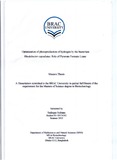Optimization of photoproduction of hydrogen by the bacterium Rhodobacter capsulatus: role of Pyruvate Formate Lyase
Abstract
The bacterium Rhodobacter capsulatus uses solar energy to produce hydrogen, a clean
energy from many organic substrates derived from renewable sources. Two types of
enzymes can catalyze the reduction of protons to H2, namely nitrogenase and
hydrogenase. Although much progress has been made in the elucidation of gene
expression, structure and regulation of these key enzymes, no practical and economically
competitive process for the continuous production of biological H2 (biohydrogen) has, as
yet, been put on the market. One of the difficulties is due to the fact that in the
photoproduction of H2, other photofermentation reactions compete with the nitrogenase
and thus reduce the efficiency of H2 production. So, the aim of this project is to enhance
hydrogen photoproduction by minimizing the competing photofermentaion reactions. In
doing so, we have observed hydrogen production in the presence of lactate or malate as
carbon sources and limited concentration of nitrogen. These organic substrates are
dissimilated through some pathways and molecular H2 results from the direct reduction of
protons from water. For the complete dissimilation of carbon substrates to H2 and CO2,
carbon source is depleted from the medium through metabolism. In a step of lactate or
malate catabolism, pyruvate is produced by the action of an enzyme pyruvate formate
lyase. This produced formate in the metabolic pathway competes with the H2 by sharing
the same metablites, and H2 production is decreased. For this reason, the gene encoding
this enzyme, pyruvate formate lyase, is targeted to switch off by transposon mediated
mutagenesis. Here the 2 types of pfl genes B and D were in target and mutagenesis was
performed successfully. But at the end, in the biochemical tests for checking formate
production from the mutant culture, still it was observed slight production of formate. So
from this point of view, the experiment was confusing. But the molecular biology
approaches like PCR and hybridization techniques were followed further to check the
presence of mutated gene products and the experiments were successful in that regard.

